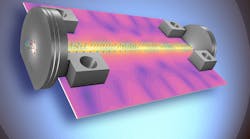Held Oct. 4-6 in Boston, the COMSOL Conference 2017 featured keynote sessions, a large number of mini-courses, and many user presentations. Those in attendance represented a wide range of disciplines, demonstrating the large scope of COMSOL’s software.
At the conference, the company announced the upcoming release of the latest version of its multiphysics software, COMSOL Multiphysics 5.3a. The new release will include a number of features that are sure to benefit those in the RF/microwave industry who are currently—or perhaps considering—using COMSOL Multiphysics. Version 5.3a is scheduled to be released before the end of 2017.
One notable update of this latest version is the addition of more than 60 substrate materials to the material library. Users will be able to choose from a large number of Rogers substrates that are now included in the software. Previously, a designer would need to select a blank material and then manually enter the material properties. The addition of these substrates eliminates the need to manually enter the properties for these particular ones. In addition, more substrates are expected to be added to the library in the future.
The addition of the new substrate materials isn’t the only update. RF/microwave engineers can also look forward to a new Adaptive Frequency Sweep. This capability will allow users to compute the frequency response of a linear model more efficiently while using a very fine frequency resolution with the asymptotic waveform evaluation (AWE)—a reduced-order modeling technique.
In addition, the release of COMSOL 5.3 earlier this year introduced a new RF parts library (not to be confused with the material library). Version 5.3a will update the RF parts library by including edge-launch connectors from Signal Microwave (www.signalmicrowave.com). These connectors assist in modeling RF components that support high-speed connections and high data rates (see figure).
As mentioned earlier, the conference featured a number of mini-courses. One of particular interest to RF/microwave engineers was titled “Electromagnetics: Wave Electromagnetics, from RF to Optical.” The mini-course discussed some of the latest updates to the RF Module add-on, as well as various tips and tricks. One specific topic focused on how the RF Module can allow bandpass-filter-type devices to be modeled faster. Another mini-course pertinent to RF/microwave engineering was a hands-on electromagnetics session.
Anyone interested in learning how to model these applications can contact COMSOL for a live demo. In addition, the COMSOL blog contains a number of useful posts.

